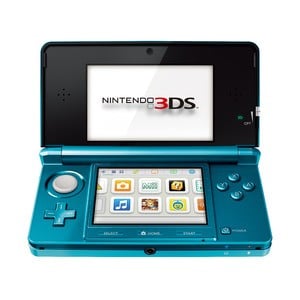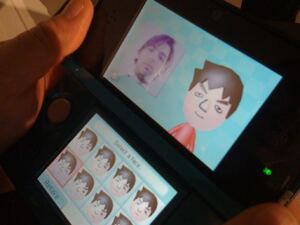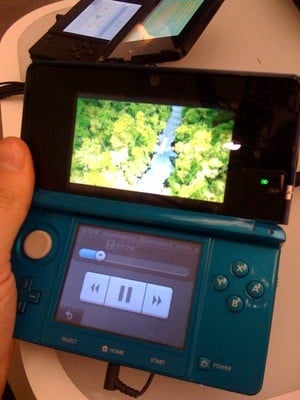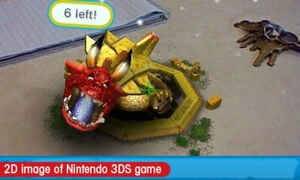
There are a ton of unknowns still left for Nintendo to address when it comes to the upcoming 3DS handheld, and the hardware's operating system itself it was one of the least-accessible aspects of our time with the device in New York and Amsterdam on Jan. 19. While lovely Nintendo reps were able to walk us through a bit of it, we were able to wrestle away a few demo units to poke about.
Main menu
We found the 3DS home screen to be very similar to the DSi's, only much more beefed up. To start with, the 3DS will have many more spaces than the DSi for what we'll call "channels," as in downloads, applications and anything else you'd want to boot right in to. The menu itself has learned a new trick since DSi's fairly static line of items: you're now able to zoom in and out in order to fit up to 64 items on-screen at once.
While we know that the eShop and Internet browser will be made available as a download at a later date, day-one buyers should see some standard channels pre-installed: Sound, which we gather is pretty much the same as it is on DSi; 3D Movie Viewer; Camera, which now supports 3D photography but is otherwise pretty much grainy as on DSi; Notifications, for StreetPass and checking up on your pedometer progress and coin count; Mii Plaza; Game Notes; Settings; Friend List; as well as Face Raiders and AR Games. These channels were only what we were able to gleam from our short time with the device and is by no means an exhaustive list of pre-installed software.

Multitasking
One of the more interesting opportunities the new Home button allows is for cross-app multitasking. In case you get stuck in, say, The Legend of Zelda: Ocarina of Time 3D, a quick hit of the button will pause the game and bring up a menu bar of four apps on the touchscreen: Notifications, Game Notes, Browser and Friend List. By tapping the Browser icon, which we were unfortunately unable to test, you're able to bring up the whole Internet to look up the solution to your problem. Once you've got it, you can tap Home again and jump in to Game Notes to scribble down the solution so you don't forget, and then jump back into your suspended game right where you left off. It's a degree of multitasking that consoles haven't really seen yet, and it's nice to see someone innovate in this field for portables.
Tapping Home also fills the bottom screen with your main menu options in case you want to change what you're doing or playing altogether.
Miis
Wii users should be pretty familiar with the setup of Miis built-in to the 3DS, as it looks and feels pretty much identical to its older sibling. The creation interface is virtually identical save for a few new customization options, and if you'd rather not toil for hours crafting a Mii in your likeness then the new Mii Maker should be right up your alley. After lining up your eyes and mouth for a photo, the 3DS takes the image of your face and creates a new Mii based on it. Our experience with it was a bit mixed; while on one hand it did in fact create a Mii based on us, the resemblance was hardly uncanny, mistaking our downward-angled face for a chubby, squinted version of ourselves.

You'll be able to see and prod all of the Miis created on your own handheld as well as any of those picked up via StreetPass in the Mii Parade. You're also able to import Miis from a Wii, but bear in mind that it's a one-way track (for now, at least): Miis on a 3DS are not transferable back to a Wii due to the new customization options on the handheld. Don't worry about losing your Wii Mii though, as it's not copied over to the handheld and then erased from your console: a copy is sent over in the transfer.
3D Movie Viewer
We were able to check out trailers for Yogi Bear and Born to be Wild using 3D Movie Viewer, and while pretty basic worked quite well. Up top played the movie and below were some nice and chunky controls for play, pause, fast-forward and rewind as well as a time bar scrubber. When a movie played on the top screen, the bottom screen darkened to avoid competing for your attention — an appreciated touch.
The 3D slider didn't seem to have the same granular role as it does on the games we had tried earlier, instead seeming to act as an on-off toggle for the stereoscopic effect. We noticed that the 3D effect looked to be set pretty low, but we were unable to find out whether viewers will be able to crank it up notably or if it's as binary as we found it to be.

Face Raiders
A gyroscope-enabled game, the premise will be familiar to anyone who's played DSiWare's System Flaw Recruit, but with a facial twist. To begin the game you must snap a photo of a face, using either the internal or external camera, that is then placed onto a polygon model of a head. This isn't the strangest part either: your job is to move around in real life, using the 3DS's internal gyroscope to track your movement, and fire tennis balls at the faces to "save" them. Other people you've snapped appear in game, and you score extra points by plopping a tennis ball into someone's mouth, with a time limit tasking you to set your best score.
It's a very simplistic game, as you'd expect from a free piece of software that comes with the console, but it provided us with some decent entertainment. The gyroscope-driven motion control is sensitive enough for small motions and capable of keeping up with faster movements too, and proves far more reliable than the camera-based control of similar DSiWare games. It's very difficult, however, to move the 3DS around and stay within the 3D screen's "sweet spot", so players may want to have switch to 2D mode when playing this and other gyroscope games.
AR Games
Inside the 3DS retail box you'll find six Augmented Reality, or AR, cards. These cards, when combined with the 3DS's external cameras, allow you to play games using a combination of real-life and computer-generated graphics. One such game was available for us to try out, and it proved surprisingly fun.

Placing a card bearing the image of a classic Super Mario question mark block on the table, pointing the camera at the card caused a transformation to occur: the box opened up and out came a series of targets to shoot. Moving the 3DS in any direction changes your view on-screen, making it possible to walk around the card and inspect it from all angles, something that soon becomes essential as new targets appear from all angles.
After destroying several targets a hefty monster – looking not unlike Steelix, Pokémon fans – emerges from the box, and the challenge is to shoot its individual segments enough times to send it packing. This requires lots of moving around the card, shooting it from above, behind and both sides, and even in a small space with several other players around this proved easy and responsive, as long as you don't mind bobbing around in real life.
As with Face Raiders, the combination of gyroscope play and 3D was not a flawless one, as the angles necessary to hit the targets will require a great deal of moving around, making it hard to stay inside the screen's sweet spot. It's not impossible, and with practice it may become easier, but players may struggle at first.

It's a smart move by Nintendo to package the console with Face Raiders and the Augmented Reality cards, allowing players to get a feel for some of the less traditional forms of gaming 3DS can offer. It's not hard to foresee similar titles hitting the eShop in future, or retail titles arriving with unique AR cards inside to offer new features and minigames.
For exciting 3DS hardware and game impressions spoken into your ear, be sure to check out the latest episode of the Nintendo Life Podcast!
—James Newton and Jonathan Wahlgren contributed to this report.





Comments 58
Cool
Really hoping for support of 3D movies. The AR games will probably become a fave of mine
So, are we going to be able to put our own videos on the 3DS ,or just watch videos Nintendo add to it.
@mark3: They didn't say either way. All we know is that the cameras won't do video recording.
I like the sound of AR, which I didn't quite understand up till now. Hooray for multitasking! The screenshot doesn't really look like steelix.
i hope they keep the idea of 3d movies on there that will create more attention to the 3ds if they do something like download a movie it would probbably work like the dsi shop thing with the new prepaid cards yay im so pumped for the 3ds!
I can't wait for the AR Games.
same here i want the 3d movies too
My iPad has multitasking. Pretty handy too, I must say. :3
I imagine I'll be playing all of the gyroscope games with 3D turned off. I cba to keep my head perfectly perpendicularly pivoted to the screen 100% of the time.
thumbnail tells me someone used agif instead of a png...
@pixelguy
The multitasking model of the latest iOS on iPhone and iPad is nice but not a great model to follow for a game-centric device, because all apps you've opened continue to stay in memory and affect resources until you completely shut them down, which is typically a hassle and means some loss of overall performance if you're not careful.
From what I can tell, the 3DS will let you keep your game running while hitting certain other apps like the internet or notes, but will (hopefully) not keep multiple games running, and will somehow shut off the previous game entirely if you choose to open a new one.
@warioswoods: Correct about the multitasking. As mentioned, you can only hop between your game, Notifications, Browser, Friend List and Game Notes. While the main menu screen pops up when you hit Home and you can jump to another application, jumping anywhere apart from those destinations will exit the current application/game.
The second image is what happens when you press Home. You can see the multitask bar at the top of the bottom screen and the main menu filling out the rest.
@Bensei: Definitely used a PNG, don't know why it looks like that on the main page and not here.
According to an Iwata Asks feature from a while back, movies displaying in 3D will indeed only be capable of toggling between on/off; the depth will not be mutable in the same way as games that are rendering the images in real-time.
Is anyone else thinking of having a little Link hide behind a sandwich on your kitchen table to avoid a boss's attack. I would love to see AR Zelda!
Well Jon, I remember in the Iwata Asks issue on the 3DS that 3D video capture could be a possible future update.
Hopefully it will be a possibility.
Come on people, Pokemon Stadium AR would be awesome!
@Sylverstone: I'm just talking out-of-the-box, but good to know! I thought the 3D camera was really cool myself, but it's hardly high quality. Plus, not sure what exactly to do with the photos or potential videos...don't exactly have a lot of 3D devices kicking around yet!
Sounds FUNNNN!
That's very interesting, and I really like the new multitasking ability. So far, it sounds like the 3DS is quite a good improvement over the DSi.
The multi-tasking is a nice addition. Face raiders doesn't look that good but the AR games look fun.
I want it (now)!
Glad to hear the AR games are fun! That and Super Street Fighter4 will have to keep me entertained till the eShop or Kid Icarus: uprising hit. =)
Great article, and good to hear that the podcast is making a comeback (but don't call it that, it's been here for years)...
This sounds awesome. Glad it gets bundled with something in game form.
Perhaps this makes me lame, but I'm quite excited about the multi-tasking feature for taking game notes. I was bummed to find out that OoT 3D doesn't have the same note-taking ability as Phantom Hourglass and Spirit Tracks, but this is a nice remedy, and you can use it for every game. Nice
I'm really looking forward to shooting that ugly Steelix-ripoff in the face.
The 3D slider won't be able to adjust the 3D effect of movies or photos taken, essentially anything pre-recorded. The slider relies on the fact that games are rendered in real-time and therefore the effect can be manipulated. How much depth you see in pre-recorded content will depend on the people creating the content. (Info via Iwata Asks interviews)
This inability to stay in the 3D sweetspot issue is troublesome. Why include the 3D at all if we're just going to have to turn it off? I'm starting to think I'd rather they lowered the cost and left out the 3D. It's sounding an awful lot like an expensive gimmick addition.
@Crunc: Well, you'd really only have to turn it off for the motion-related things, which I doubt will be the majority, and like the article says, it may get easier with practice. Is it so much to ask for a little work on your part?
Yeah...the AR cards have a lot of potential...I hope they do a YuGiOh one, I still have my crap load of cards that have been gathering dust here. Would be awesome if the 3DS could read those.
I hope they continue to support AR cards. It would be a pity for an awsome feature to only have six cards.
@EmpireIndustries: I can see it now: Nintendo 3DS AR Booster Packs, only $9.99 for 3 cards!
Oh man I was going to avoid getting one at the launch date, but you guys make it so hard!
Awesome!
the ar cards sound awesome, and i hope they make more for individual sale
That's great to hear that the net browser specifically is multi-task friendly. I've always wondered why this entire generation missed that capability...I'd actually get some use out of the PS3 browser if this function existed on it--as it stands my iphone tends to be my walkthrough/game info-if-needed browser.
Good game Nintendo. That was great to hear.
I hope the AR cards will be released like collectible trading cards. But I also hope they won't become like the SMA4:SMB3 cards, where most weren't released in the west.
This is the first time I've seen any of the UI or the icon for the "3D Movie Viewer," so I've got a question for NintendoLife:
Can you describe/do you have pictures of the top-level UI in the 3D Movie Viewer app? Like the screens where you choose what to watch and how it's displayed? Thanks a ton!
What I'd like to know is about those AR cards... Are they just a normal card that looks like a question block that when the 3DS sees, it produces all the computer generated-ness, OR is there some chip in the AR cards & hence if I went & played the same card again, it would show the same challenge again?
I'd preorder mine that AR game card looks cool so cool.
Woooooooow, I'm SO hoping to get upgrades for AR cards and maybe a collectible card game around it...
@WiiLovePeace: They'll just literally be a card with a symbol on. AR tech on phones works in a similar fashion, recognising specific symbols. Usually you can just print them out off a website using your PC then download the software to your phone and have its camera look at the symbol.
I'm psyched about the notes function. The ability to write/draw on the map was the best feature added to Zelda. I won't have to be tied to my computer to take notes which is great. Browser will be handy for Pokemon too.
Hopefully the browser being able to run in the background means we can finally use it to establish a connection with a public wifi and then play a game over that same connection, something that isn't possible with the DSi and was a huge shortcoming.
The game notes thing sounds cool. Also, it would be great to have a FPS where computer generated characters move around in real environments. Like you actually are in the game. So basically Face Raiders, but more advanced.
Hurray for multitasking!
Hope the AR cards get say, Pokemon and Yu-Gi-Oh! card sets of em.
That's it! INSTA-PREORDER!!!
*Hopes for green skin, mohawk, and good red hair options to be among updated Mii options.
I NEED A JOB! FIRST, drivers liscense. grr... I hate being poor...
The Multitasking and AR Cards are what im looking forward to most besides the games of course.
This sounds cool.
I can't wait for the 3ds it's going to be fun
best handheld system ever!!!!
yu-gi-oh cards with 3DS support would be OhDeeee FUN!!
augmented reality ftw!!!!!!!!!!
like 13 more days until it comes out in japan
Cant wait for AR cards!!!!!!!!!!
Tap here to load 58 comments
Leave A Comment
Hold on there, you need to login to post a comment...